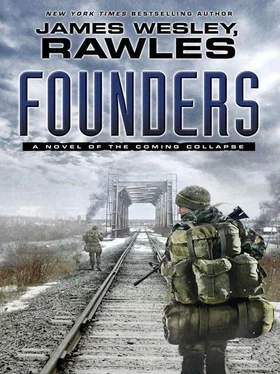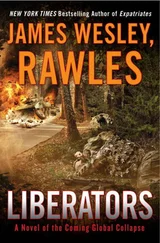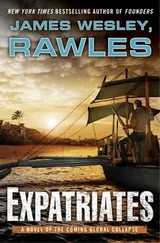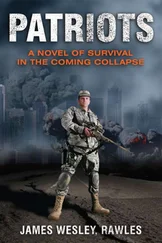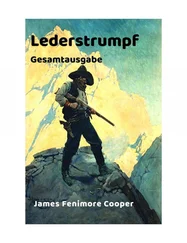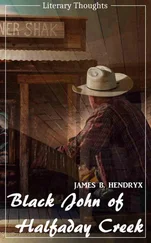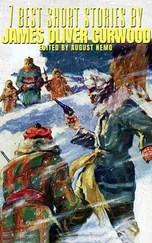James Rawles - Founders
Здесь есть возможность читать онлайн «James Rawles - Founders» весь текст электронной книги совершенно бесплатно (целиком полную версию без сокращений). В некоторых случаях можно слушать аудио, скачать через торрент в формате fb2 и присутствует краткое содержание. Город: New York, Год выпуска: 2012, ISBN: 2012, Издательство: Emily Bestler Books, Жанр: sf_postapocalyptic, на английском языке. Описание произведения, (предисловие) а так же отзывы посетителей доступны на портале библиотеки ЛибКат.
- Название:Founders
- Автор:
- Издательство:Emily Bestler Books
- Жанр:
- Год:2012
- Город:New York
- ISBN:978-1-4391-7282-7
- Рейтинг книги:5 / 5. Голосов: 1
-
Избранное:Добавить в избранное
- Отзывы:
-
Ваша оценка:
- 100
- 1
- 2
- 3
- 4
- 5
Founders: краткое содержание, описание и аннотация
Предлагаем к чтению аннотацию, описание, краткое содержание или предисловие (зависит от того, что написал сам автор книги «Founders»). Если вы не нашли необходимую информацию о книге — напишите в комментариях, мы постараемся отыскать её.
Founders — читать онлайн бесплатно полную книгу (весь текст) целиком
Ниже представлен текст книги, разбитый по страницам. Система сохранения места последней прочитанной страницы, позволяет с удобством читать онлайн бесплатно книгу «Founders», без необходимости каждый раз заново искать на чём Вы остановились. Поставьте закладку, и сможете в любой момент перейти на страницу, на которой закончили чтение.
Интервал:
Закладка:
The team left a dozen empty 55-gallon drums sitting just outside the CONEX doors. These drums also had convincing-looking MTBE markings stenciled on them and they all had their bungs sealed shut. In the event that the team had to camouflage their operation from officials, they could pile up the barrels just inside the door, blocking the view of the electronic racks and chairs, which sat farther back, behind a blackout curtain. A pint can of paint thinner was kept handy, so that the floor inside the doors could be doused to give the CONEX a convincing aroma.
Several times, Martin’s team practiced disconnecting the antennas and “shore power” to the CONEX and securing the rolling chairs. They then loaded it onto an eighteen-wheel truck that had a self-loader. Their goal was to be able to displace tactically with just fifteen minutes notice. They eventually got their time down to sixteen minutes. In the event that it ever became necessary to relocate where there wasn’t grid power, they also had two pickup trucks towing generator trailers that would go with them.
Once the UNPROFOR troops had entered the Four Corners region, L. Roy opted to leave the CONEX on the truck at all times, giving them the ability to displace even more quickly. They soon became accustomed to climbing the ladder to access the CONEX, regardless of the weather.
After word came that the Federals were on their way to Farmington, they relocated the CONEX to a large gas drilling equipment yard halfway between Bloomfield and Farmington. There, the CONEX was lost in the clutter of rusting compressors, drip tanks, boom trucks, stacks of pipe, and other shipping containers.
A 250-vehicle UNPROFOR convoy rolled into Farmington. They soon established smaller garrisons in Bloomfield and Aztec. A “protection team” was dispatched to L. Roy Martin’s refinery, escorting Chambers Clarke, a former fertilizer salesman who was the deputy minister of information for the Hutchings administration. Clarke had been specially tasked with securing key strategic assets, such as refineries and large power plants, as the UNPROFOR’s pacification campaign continued.
In a private conversation with his plant manager, Phil McReady, three days before the UN forces arrived, Martin had said, “The guys from the pacification contact team from the Fort Knox government will be here tomorrow. What I want you to do is quietly tell everyone to just play along, and carry on operations as usual. We want to lull the ProvGov to sleep, thinking that our refinery is safely their refinery and that the Navajo coal mine and the power plants are theirs , too. We need to make them assume that there won’t be much resistance in the Four Corners region. That way, they’ll leave just a small garrison and move on. But right under their noses, we’ll be diverting fuel and lubricants to resistance groups all over the Southwest. I’ve already discussed this with the tribal elders.”
McReady nodded, and Martin continued, “So tell everyone: Do not sabotage any equipment or interrupt any processes. We’re the only ones who know how to operate this plant, so it will continue to be ours. It’s a lot like things were in Italy under the fascists.”
Phil grinned hugely and said, “So the trains still run on time, even though we’re plotting against Il Duce , and providing logistics for la resitenza. ”
L. Roy shouted, “ Minuziosamente! ” They shook hands.
The next day, L. Roy’s conversation with Chambers Clarke lasted less than an hour. Clarke came across as a saccharine-sweet character, full of promises about ProvGov protection and sumptuous benefits in exchange for nationalization of the refinery and its associated pipeline infrastructure.
Recognizing the UNPROFOR’s disproportionate firepower, L. Roy feigned a cooperative, pro-Hutchings attitude. But he bargained hard for salaries for all his employees, even carving out a concession that part of their pay would still be in the form of bartered fuel. Only two days after the Federals arrived, L. Roy turned day-to-day operations of the refinery over to Phil McReady.
Martin publicly announced that he planned to take “a well-deserved and much delayed fishing vacation.” But after just two days at his ranch, he started working two twelve-hour shifts each week at the CONEX. Later, once it was clear that his actions weren’t attracting suspicion, he increased his workload to four twelve-hour shifts per week.
Just as he had been doing before the UN forces arrived, Martin kept his SIGINT team small, realizing that one any larger was sure to be detected or infiltrated. The core of Martin’s team was Pat Wicher, a retired Air Force senior master sergeant (SMSgt) who had for many years been on the cadre of joint service field stations for the Air Force Security Command (AFSC). Wicher had worked all over the world at both tactical and strategic levels, communications intelligence (COMINT), and electronic intelligence (ELINT) intercept and analysis. A good portion of the gear at the refinery’s intercept site came out of the collection in Wicher’s garage and attic. Wicher had squirreled away an impressive array of electronics. Most importantly, he owned two spectrum analyzers—a continuous swept-tuned analyzer and a wideband snapshot analyzer. These were crucial for the mini–field station’s mission. With them, rather than simply scanning through the spectrum, they could see signal spikes where they could then quickly tune. Wicher even knew how to use an oscilloscope to realign receivers. L. Roy was constantly amazed at the breadth and depth of Pat’s knowledge.
Partly because the ProvGov could no longer rely on an intact technological infrastructure to keep encrypted and frequency-hopping radios working, and in part because of their arrogant condescension, they made many transmissions “in the clear” and they used obsolete encryption methods such as Four-square and Playfair substitution ciphers, which were easily broken. Because they assumed that the Resistance was not listening in some bands or that their ciphers could not be broken, the ProvGov and its army often had its communications compromised. This yielded a wealth of practical intelligence to the Resistance.
L. Roy Martin’s team very rarely transmitted, and only then in the HF band via skywave, because it was very difficult to locate via direction finding other than via groundwave in the immediate vicinity of the transmitter.
Bloomfield, New Mexico
August, the Third Year
At their ranch near Bloomfield, New Mexico, Lars Laine and his brother Andrew launched into another one of their conversations about resistance to the Provisional Government. The brothers were both Army veterans. The elder brother, Lars, had been given a disability discharge in the aftermath of a roadside bomb explosion. That incident cost him a hand, an eye, and the hearing in one ear. The younger brother, Andy, had been released from active duty as a captain at the end of his six-year contractual obligation, just as the Crunch was unfolding. He was stranded in Germany, with all military and commercial airline flights grounded. He resorted to buying a bicycle and trailer, and pedaling across Germany and France. On the coast of France, he used part of his dwindling supply of small gold and silver coins to pay for passage to England on a French fishing boat. From there, he pedaled up the east coast, finally finding work as a hired security man on a yacht that would soon sail for Belize. In Belize, following an ambush by bandits that left him with a broken leg, Andy bought a horse and made his way by horseback up through Mexico, crossed into Texas, and finally made his way back to the family’s ranch in New Mexico.
Lars and Andy had spent the evening in the “radio shack” corner of the master bedroom, listening to the massive Scott SLRM multiband radio that had belonged to their late father. The old vacuum tube radio was originally designed for use on U.S. Navy ships, just before World War II. It was a very robust boat anchor design that weighed eighty-five pounds. The radio’s most distinguishing feature was that it had a green cathode ray tuning eye. The front of the cabinet was stained yellow-brown with tobacco smoke from its original Navy service. The radio was powered by an isolation transformer, which was considered a must for safety with these radios, because of the shock hazard of running one without isolation.
Читать дальшеИнтервал:
Закладка:
Похожие книги на «Founders»
Представляем Вашему вниманию похожие книги на «Founders» списком для выбора. Мы отобрали схожую по названию и смыслу литературу в надежде предоставить читателям больше вариантов отыскать новые, интересные, ещё непрочитанные произведения.
Обсуждение, отзывы о книге «Founders» и просто собственные мнения читателей. Оставьте ваши комментарии, напишите, что Вы думаете о произведении, его смысле или главных героях. Укажите что конкретно понравилось, а что нет, и почему Вы так считаете.
